
Aluminium is a chemical element; it has symbol Al and atomic number 13. Aluminium has a density lower than that of other common metals, about one-third that of steel. It has a great affinity towards oxygen, forming a protective layer of oxide on the surface when exposed to air. Aluminium visually resembles silver, both in its color and in its great ability to reflect light. It is soft, nonmagnetic, and ductile. It has one stable isotope, 27Al, which is highly abundant, making aluminium the twelfth-most common element in the universe. The radioactivity of 26Al, a more unstable isotope, leads to it being used in radiometric dating.
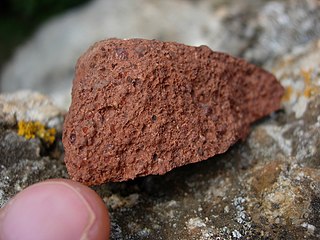
Bauxite is a sedimentary rock with a relatively high aluminium content. It is the world's main source of aluminium and gallium. Bauxite consists mostly of the aluminium minerals gibbsite, boehmite and diaspore, mixed with the two iron oxides goethite and haematite, the aluminium clay mineral kaolinite and small amounts of anatase and ilmenite . Bauxite appears dull in luster and is reddish-brown, white, or tan.
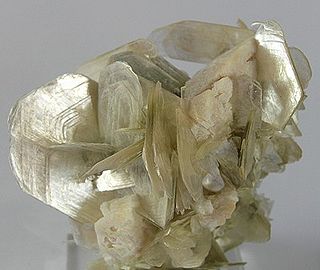
Muscovite (also known as common mica, isinglass, or potash mica) is a hydrated phyllosilicate mineral of aluminium and potassium with formula KAl2(AlSi3O10)(F,OH)2, or (KF)2(Al2O3)3(SiO2)6(H2O). It has a highly perfect basal cleavage yielding remarkably thin laminae (sheets) which are often highly elastic. Sheets of muscovite 5 meters × 3 meters (16.5 feet × 10 feet) have been found in Nellore, India.
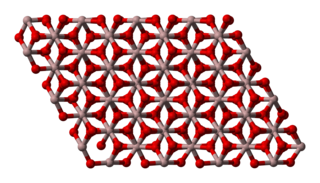
Aluminium oxide (or aluminium(III) oxide) is a chemical compound of aluminium and oxygen with the chemical formula Al2O3. It is the most commonly occurring of several aluminium oxides, and specifically identified as aluminium oxide. It is commonly called alumina and may also be called aloxide, aloxite, or alundum in various forms and applications. It occurs naturally in its crystalline polymorphic phase α-Al2O3 as the mineral corundum, varieties of which form the precious gemstones ruby and sapphire. Al2O3 is significant in its use to produce aluminium metal, as an abrasive owing to its hardness, and as a refractory material owing to its high melting point.
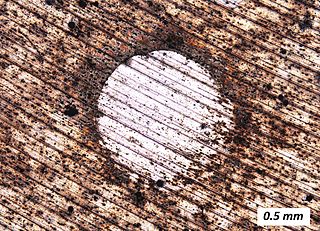
Duralumin is a trade name for one of the earliest types of age-hardenable aluminium–copper alloys. The term is a combination of Dürener and aluminium. Its use as a trade name is obsolete. Today the term mainly refers to aluminium-copper alloys, designated as the 2000 series by the international alloy designation system (IADS), as with 2014 and 2024 alloys used in airframe fabrication.

Aluminium foil is aluminium prepared in thin metal leaves. The foil is pliable and can be readily bent or wrapped around objects. Thin foils are fragile and are sometimes laminated with other materials such as plastics or paper to make them stronger and more useful.

The Maserati 3200 GT is a four-seater grand tourer produced by Italian automobile manufacturer Maserati from 1998 to 2002, replacing the Shamal as the flagship grand tourer of the marque. The luxury coupé was designed by Italdesign, whose founder and head Giorgetto Giugiaro previously designed, among others, the Ghibli, Bora and Merak. Interior design was commissioned to Enrico Fumia and completed by 1995. 4,795 cars were produced before it was replaced by the Maserati Coupé.
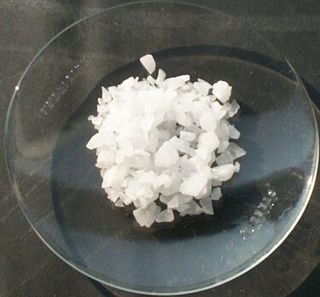
Aluminium sulfate is a salt with the formula Al2(SO4)3. It is soluble in water and is mainly used as a coagulating agent (promoting particle collision by neutralizing charge) in the purification of drinking water and wastewater treatment plants, and also in paper manufacturing.

Aluminium bronze is a type of bronze in which aluminium is the main alloying metal added to copper, in contrast to standard bronze or brass. A variety of aluminium bronzes of differing compositions have found industrial use, with most ranging from 5% to 11% aluminium by weight, the remaining mass being copper; other alloying agents such as iron, nickel, manganese, and silicon are also sometimes added to aluminium bronzes.

Aluminium phosphide is a highly toxic inorganic compound with the chemical formula AlP, used as a wide band gap semiconductor and a fumigant. This colorless solid is generally sold as a grey-green-yellow powder due to the presence of impurities arising from hydrolysis and oxidation.

The moka pot is a stove-top or electric coffee maker that brews coffee by passing hot water driven by vapor pressure through ground coffee. Named after the Yemeni city of Mocha, it was invented by Italian engineer Luigi Di Ponti in 1933 who sold the patent to Alfonso Bialetti, an aluminum vendor. It quickly became one of the staples of Italian culture. Bialetti Industries continues to produce the original model under the trade name "Moka Express".

The Alfa Romeo Scighera is a functional, futuristically styled concept car designed by Fabrizio Giugiaro and manufactured by Italdesign of Turin, Italy in 1997 for automobile manufacturer Alfa Romeo. The name "Scighera" means mist in the Milanese dialect.
6061 aluminium alloy is a precipitation-hardened aluminium alloy, containing magnesium and silicon as its major alloying elements. Originally called "Alloy 61S", it was developed in 1935. It has good mechanical properties, exhibits good weldability, and is very commonly extruded. It is one of the most common alloys of aluminium for general-purpose use.
Aluminium–air batteries produce electricity from the reaction of oxygen in the air with aluminium. They have one of the highest energy densities of all batteries, but they are not widely used because of problems with high anode cost and byproduct removal when using traditional electrolytes. This has restricted their use to mainly military applications. However, an electric vehicle with aluminium batteries has the potential for up to eight times the range of a lithium-ion battery with a significantly lower total weight.

The Alfa Romeo Giulietta is a family of automobiles made by Italian car manufacturer Alfa Romeo from 1954 until 1965 which included a 2+2 coupé, four-door saloon, estate, spider, Sprint, and Sprint Speciale. The 2+2 was Alfa Romeo's first successful foray into the 1.3-litre class. From 1954 to 1965 a total of 177,690 Giuliettas were made, the great majority in saloon (Berlina), Sprint coupé, or Spider body styles, but also as Sprint Speciale and Sprint Zagato coupés, and the rare Promiscua estate.
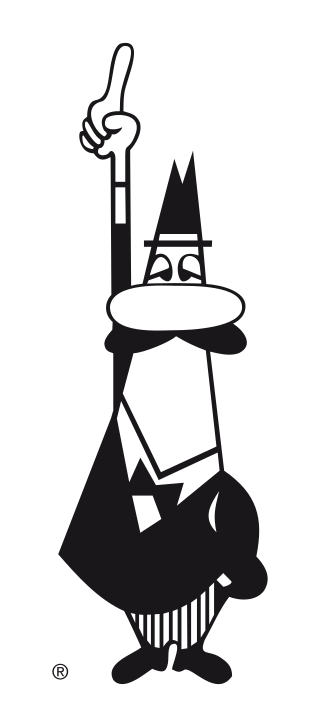
Bialetti is an Italian brand of coffee machines, cookware and small kitchen appliances founded by Alfonso Bialetti. The brand is owned by Bialetti Industries.
KiteGen is a concept for a wind harnessing machine for high altitude winds, developed in Italy. The vertical axis rotation is intended to eliminate the static and dynamic problems that limit the size of conventional wind turbines. The prototype STEM yo-yo is under construction at Berzano di San Pietro in Italy.














